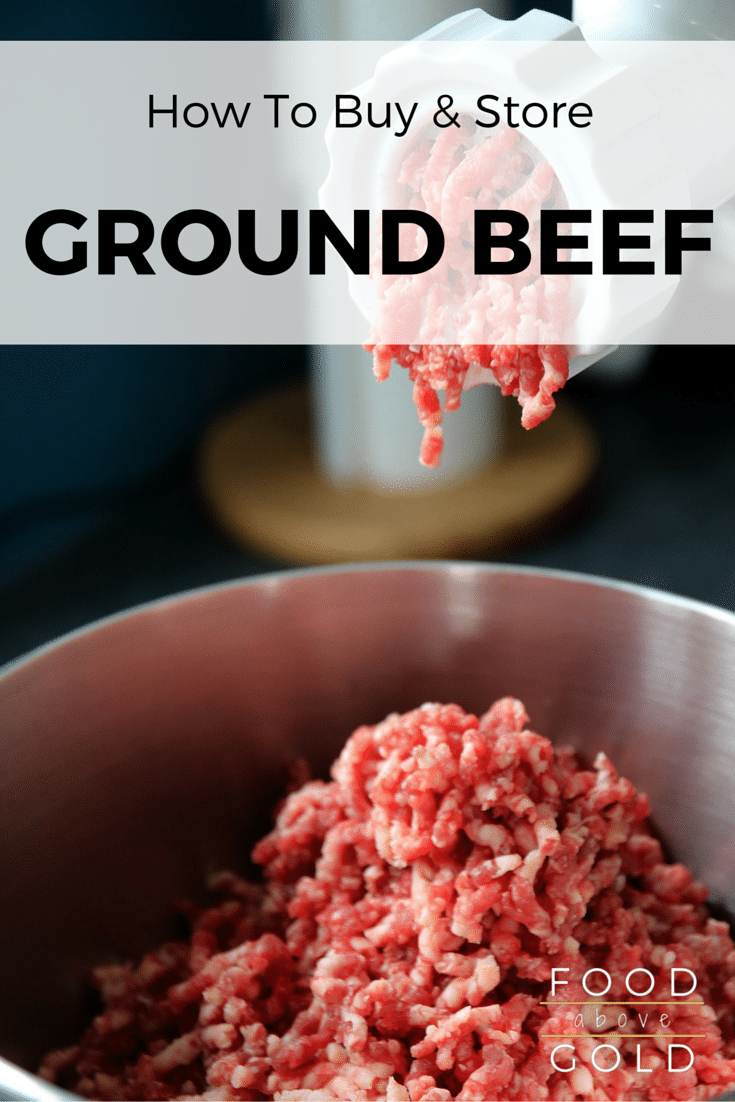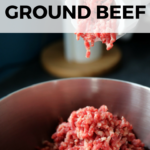Learn how to buy and store ground beef, the different names of ground beef, & find out which lean-to-fat ratios are the best for what you're making.

In my effort to provide you with all of the best information possible about ground beef, I originally wrote a 4,000 word post that went into a ridiculous amount of detail. It not only covered how to buy and store ground beef, but also how to understand USDA labels. Instead of overwhelming you with all that information at once (and to help keep some semblance of brevity, which we all know isn't my strong suit 😉 ), I've decided to break it down into two different posts. This one on how to buy and store ground beef, and this one on how to understand USDA labels. I highly encourage you to go read it before your next trip to the grocery store because it has some very important information about recent changes to beef labeling.
Now, on with the show...
When I was young, there was a big push for everyone to purchase the leanest ground beef they could find. Fat was the enemy, after all. Since then, people have learned that there are times when fat is beneficial during cooking. If you find yourself staring at the different packages of ground beef and aren't sure which one you should be getting, then this post is for you. Let's dive in!
How To Buy Ground Beef
When you're buying ground beef, there are three major things to look at: the lean-to-fat ratio, the cut, and USDA labels. Both of those things I'll cover in just a moment, but first I want to talk about some things to look for in your ground beef:
- Color. Your beef should be a nice strawberry red when you buy it. "What about the brown parts?" you ask. If it is brown on the inside, don't worry. That comes as a result of the beef not having oxygen exposure. If the outside of the beef is beginning to turn brown however, then it is time to use it or freeze it. If it is beginning to turn gray, then it's approaching spoilage, and it's time to throw it out. NOTE: Beef sold from large manufacturers is often treated with carbon monoxide before packaging to maintain the bright red color. Ask the butcher if this is something you're concerned about.
- "Use By Date". Use by dates mean to help you determine when your beef is going bad. With ground beef, don't look at these. The foam/plastic containers may help with extending the life of the ground beef, but it is more important to look at the "packaged on" date. Ground beef has a shelf life of about 2 days, buy the package with the packaging date that is the closest to the day you are purchasing to ensure freshness.
- In-house Grinding. Your grocery store may grind the beef fresh for you if you ask. Not all grocery stores do this, but if yours does, you know you are getting the freshest you possibly can. If you do this, remember that the meat will hold shape better with a finer the grind. This also applies for the frequency of grinding. This is great for hamburgers and meatballs, but not necessarily the best for tacos.
Now that you know all the key features of things to look for when you're buying ground beef, let's look at the major things: the different names of ground beef, lean-to-fat ratios, and USDA process verifications and gradings.
Different Names for Ground Beef
Imagine that you have two packages of ground beef in your hands. One has a label saying ground round, the other says ground chuck. Do you know the difference? How would you use it to help you decide which to buy? Is it different from hamburger?
Ground beef, also known as hamburger, is a combination of primal cuts (your basic cuts, not weird things) that are ground down with no more than 30% fat. If the packaging states that it contains ground round or ground chuck, for example, that means the meat comes purely from that cut of the cow, not a combination of cuts.
Legally, beef can't be titled as "ground beef" if it has any added water, phosphates, additional meats, or binders.
Meat's flavor is determined by fat, not by the meat itself. The fattier your ground beef is, the more flavorful it will be. These meat-to-fat ratios are called lean-to-fat ratios, and they are what we'll look at next.
Understanding Lean-to-Fat Ratios
The lean-to-fat ratio is the first thing most people pay attention to on their ground beef. This tells you how fatty your ground beef is. Did you know that unless your package of ground beef contains less than 3% fat, that meat companies can not call your ground beef "lean"? As a result, most of the packaging will say __% fat or give a lean-to-fat ratio.
The leaner the beef, the redder it will look.
Like I mentioned before, certain cuts offer a certain fat ratio, so sometimes your beef will have the cut name next to the lean-to-fat ratio, but let's look at what each is and what they are good for.
- Ground Beef/Hamburger. This is your standard ground beef. This ground beef has the most flavor and is made of a combination of primal cuts. This ground beef has 70%-79% lean meat and the rest is made of fat. This kind of ground beef is best for making juicy foods like tacos, sloppy joes, or chili.
- Ground Chuck. Ground chuck is from the shoulder of the cow and is 80-85% lean meat. It is best for making things that you want to hold their shape, like meatballs, burgers, or meatloaf. The fat ratio allows it to remain moist, but hold together and stay functional. I also like to use this for making lasagna.
- Ground Round. Ground round is cut from the rump of the cow and is 85%-89% lean meat. Ground round dries out when cooked past medium-rare (which isn't hot enough to kill bacteria) so it is best for braising or slow-cooking. This will help prevent chewiness, cook it completely, and give it enough time to absorb moisture from other sources. This is a great choice also for saucy meals, like hamburger helper or spaghetti, since it doesn't release so much fat that you need to drain it.
- Ground Sirloin : Sometimes labeled as "lean ground beef", ground sirloin comes fromt he sirloin, which is from the back/side. It usually contains 90%-96% lean meat, and becomes very dry when cooked. Most people choose ground sirloin for its low fat content, but most recipes that call for ground beef benefit from higher amounts of fat than sirloin will provide. As the most desirable cut of meat, ground sirloin is more expensive than other cuts usually.
What Is The Best Ground Beef?
As a basic, all-around ground beef, ground chuck is the best. If you are concerned about the amount of fat that comes with it, you can strain the beef grease after browning by placing a heatproof container (glass jar works great) in your sink with a sieve or mesh colander (cheesecloth-lined if you want) on top. Make sure that the mouth of the jar is at least as wide as the base of your sieve. Pour your browned beef into the sieve, allowing the grease to strain out, then transfer your beef back to your pan to continue cooking and dispose of the grease after it has cooled.
Remember, a package of specific type of ground beef, such as ground sirloin, will cost you more than it would for ground beef of the same lean-to-fat ratio. Why? Because this requires that the butcher use the part of the primal cut specifically for making ground beef, rather than being able to use the scraps and trimmings leftover from butchering that cut for other things, like steaks.
USDA Labeling
Do you like to buy graded meat? What about meat that has USDA process verifications, like organic, or grass-fed? For more information on that, pop on over to this in-depth look at USDA labels and read up on how some recent changes in beef labeling may effect you.
Buying Local
A lot of people get nervous about purchasing meat at a farmer's market or a local farm. They are unsure of processing, or how it is cared for compared to supermarket meat. Guess what?These smaller farms take the same steps as large manufacturers and may actually be at less of a risk for bacterial contamination. Smaller farms use beef from only one place. Meat-packaging plants that supply major grocery stores use meat that is mixed together from many different farms. This may increase the chance of getting contaminated beef and also makes it harder to determine potential recalls.
When you buy from a small butcher or local farmer, they are grinding your beef for you fresh. While there is always a risk of contamination, it is less likely. To make sure that you kill all potential bacteria, cook your ground beef to the USDA recommended internal temperature of 160°F. Make sure to take the temperature in the thickest part of the meat with a quality thermometer.
How To Store Ground Beef
As with any meat, proper storage is important in quelling bacterial growth. Like I mentioned earlier, ground beef is really only good for two days. Buy it as close to when you are going to use it as possible. If you are approaching your two day mark and know that you won't be able to use it for another couple of days, go ahead and cook it, then package it up in a tightly sealed container for use later.
To store ground beef, I recommend:
- Fridge : To make it easy, you can keep your ground beef in the package that you got it from at the butcher. Since you will use it quickly you don't need to worry about preventing spoilage by moving it to another container. It will keep like this in the fridge for up to two days.
- Freezer : If you need to freeze your ground beef you can freeze it raw by double-sealing it. Do this by placing the ground beef flat in an air-tight container (such as a ziploc bag). Then place that bag down inside of another one. Alternatively, you could wrap it tightly with plastic wrap instead of the extra bag. This extra layer of insulation will help prevent freezer burn. Your ground beef can keep like this in the freezer for up to 6 months. Don't forget to put the "packaged on" date on the bag so you know when your 6 months is up!
- To defrost frozen ground beef, pull it out of the freezer and place it on a plate (or something to catch any thawing liquid) in your refrigerator 24 hours before you plan to use it.
- Leftovers : If you have any leftovers of ground beef, it will keep, cooked, in an air-tight container in your refrigerator for up to 5 days.
Practice Makes Perfect
Do you have some ground beef you need to use up? Are you wanting to try a new ground beef recipe? Here are some I recommend:
- The Not-Slippery Caramelized Onion Burger
- Brie, Basil, and Hickory Burger
- Boursin Stuffed Breakfast Burger
- Sweet & Spicy Wasabi Burger
Thanks so much for stopping by. I know that this post is long, and it's even longer if you go read about the USDA process verifications. Thanks for reading for so long ;).
Do you have any tips about how to buy and store ground beef? What is your favorite lean-to-fat ratio? Tell me about it in the comments, or show me on social media (@foodabovegold) and use our exclusive hashtag #CallMeMichelin!
Happy Cooking! 🙂



What are your thoughts?